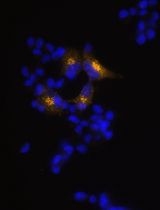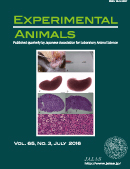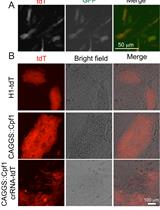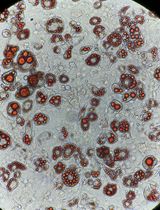- EN - English
- CN - 中文
A Protocol for Production of Mutant Mice Using Chemically Synthesized crRNA/tracrRNA with Cas9 Nickase and FokI-dCas9
利用化学合成的crRNA/tracrRNA-Cas9 Nick酶及FokI-dCas9产生突变小鼠的实验方法
发布: 2017年06月05日第7卷第11期 DOI: 10.21769/BioProtoc.2340 浏览次数: 11716
评审: Anonymous reviewer(s)

相关实验方案

利用EpiCRISPR系统通过靶向DNA甲基化诱导Alpha TC1-6细胞产生胰岛素
Marija B. Đorđević [...] Melita S. Vidaković
2025年10月20日 1205 阅读
Abstract
The clustered regularly interspaced short palindromic repeats (CRISPR)/CRISPR-associated protein 9 (Cas9) system is the most widely used genome editing tool. A common CRISPR/Cas9 system consists of two components: a single-guide RNA (sgRNA) and Cas9. Both components are required for the introduction of a double-strand break (DSB) at a specific target sequence. One drawback of this system is that the production of sgRNA in the laboratory is laborious since it requires cloning of an sgRNA sequence, in vitro transcription reaction and sgRNA purification. An alternative to targeting Cas9 activity by sgRNA is to target it with two small RNAs: CRISPR RNA (crRNA) and trans-activating crRNA (tracrRNA). Both of these small RNAs can be chemically synthesized which makes the production of these RNAs less difficult when compared to sgRNA. Another downside of the CRISPR/Cas9 systems is that off-target effects have been reported. However, modified forms of Cas9 have been developed to minimize off-target effects. For example, nickase-type Cas9 (nCas9) and FokI domain-fused catalytically-inactive Cas9 (FokI-dCas9; fCas9) induce DSBs only when two guide RNAs bind opposite strands within a defined distance. In this protocol, we describe our experimental system for the production of mutant mice using a CRISPR/Cas9 system that combines crRNA, tracrRNA, and modified forms of Cas9. This method not only facilitates the preparation of reagents for the genome editing system but it can also reduce the risk of off-target effects.
Keywords: CRISPR/Cas9 (CRISPR / Cas9)Background
The clustered regularly interspaced short palindromic repeats (CRISPR)/CRISPR-associated protein 9 (Cas9) system is an effective genome editing tool. In bacteria, CRISPR/Cas9 functions as an adaptive immune system. It consists of two small RNAs, CRISPR RNA (crRNA) and trans-activation crRNA (tracrRNA) and the Cas9 DNA nuclease, which digests targeted DNA (Jinek et al., 2013). Several groups have established the CRISPR/Cas9 system as a tool for introducing mutations in many cell types (Cong et al., 2013; Mali et al., 2013). When the Cas9 nuclease is targeted to genomic DNA, it cleaves DNA resulting in a lesion that is repaired by non-homologous end joining (NHEJ) or homologous DNA recombination. Since NHEJ can be an error-prone mechanism, mutations can be introduced into the genome when DNA is repaired by this mechanism. The CRISPR/Cas9 system can be used to edit the genomes of mice by microinjecting Cas9 and the single-guide RNA (sgRNA) into fertilized eggs. Although sgRNAs have been used extensively with success, the generation of the sgRNA is laborious because the sgRNA must be cloned from DNA oligomers and then transcribed in vitro. Systems that use crRNA and tracrRNA can eliminate much of the labor involved in preparing sgRNAs since crRNA and tracrRNA are small enough in length to be chemically synthesized. So instead of injecting Cas9 with sgRNA, mutant mice can be obtained by microinjecting Cas9 with both crRNA and tracrRNA (crRNA/tracrRNA). One drawback of using the CRISPR/Cas9, is guide RNA/Cas9 complex can generate off-target mutations, which are unintended mutations that occur at loci with similar sequences to the target sequence of the guide RNA. The risk of inducing off-target mutations can be reduced by incorporating the use of modified forms of Cas9, such as the nickase-type of Cas9 (nCas9) and the FokI domain-fused catalytically-inactive Cas9 (FokI-dCas9; fCas9). These Cas9 forms cleave target DNA only when two sgRNAs bind opposite strands with a limited distance between them (Ran et al., 2013; Hara et al., 2015). Recently, we successfully generated mutant mice by microinjecting modified Cas9s with chemically synthesized crRNA/tracrRNA into fertilized eggs (Terao et al., 2016). This protocol reduces time and labor for the preparation of targeting RNA and can reduce the risk of off-target effects.
Materials and Reagents
- 35 mm dish*
- 60 mm dish*
- Mouth pipettes*
- 0.22 µm filter*
- Microloader (Eppendorf, catalog number: 5242956003 )
- Glass capillary for mouth pipettes (Drummond Scientific, catalog number: 1-000-0500 )
- Glass capillary for holding pipettes (Sutter Instrument, catalog number: B100-75-10 )
- Glass capillary for injection pipettes (World Precision Instruments, catalog number: TW100F-4 )
- Male and female C57BL/6 x DBA/2 hybrid (B6D2F1) or other strains (for recipient zygotes)
- Male and female ICR (for preparation of pseudopregnant mice)
- Cas9 plasmids (available from Addgene)
- Nickase-type of Cas9 (nCas9) (Addgene, catalog number: 41816 )
- FokI domain-fused catalytically-inactive (fCas9) (Addgene, catalog number: 52970 )
- PrimeSTAR MAX (Takara Bio, catalog number: R045A ) or other PCR polymerases
- Qiaquick PCR Purification Kit (QIAGEN, catalog number: 28104 ) or equivalent
- AgeI*
- mMESSAGE/mMACHINE T7 Transcription Kit (Thermo Fisher Scientific, InvitrogenTM, catalog number: AM1344 )
- MEGAclear Transcription Clean-Up Kit (Thermo Fisher Scientific, InvitrogenTM, catalog number: AM1908 )
- Pregnant mare serum gonadotropin (PMSG) (ASKA Animal Health, Serotropin®, catalog number: 879412 )
- Human chronic gonadotropin (hCG) (ASKA Animal Health, catalog number: Gonatropin 3000 )
- Hyaluronidase (Sigma-Aldrich, catalog number: H4272 )
- KSOM medium (ARK resource)
- Dichlorodimethylsilane (Tokyo Chemical Industry, catalog number: D0358 )
- ExoSAP-IT (Thermo Fisher Scientific, Applied BiosystemsTM, catalog number: 78200.200.UL )
- Sodium chloride (NaCl) (Wako Pure Chemical Industries, catalog number: 191-01665 )
- Potassium chloride (KCl) (Nacalai Tesque, catalog number: 28514-75 )
- Calcium chloride (CaCl2·2H2O) (Sigma-Aldrich, catalog number: C7902 )
- Potassium phosphate monobasic (KH2PO4) (Sigma-Aldrich, catalog number: P5655 )
- Magnesium sulfate (MgSO4·7H2O) (Sigma-Aldrich, catalog number: M2773 )
- Sodium bicarbonate (NaHCO3) (Sigma-Aldrich, catalog number: S5761 )
- HEPES (DOJINDO, catalog number: 342-01375 )
- Sodium DL-lactate (Sigma-Aldrich, catalog number: L7900 )
- Sodium pyruvate (Sigma-Aldrich, catalog number: P2256 )
- D-(+)-glucose (Sigma-Aldrich, catalog number: G7528 )
- Polyvinyl alcohol (Sigma-Aldrich, catalog number: P8136 )
- Penicillin-streptomycin (Thermo Fisher Scientific, GibcoTM, catalog number: 15140122 )
- Phenol red (Sigma-Aldrich, catalog number: P0290 )
- Sodium hydroxide (NaOH) (Sigma-Aldrich)
- Paraffin liquid (Nacalai Tesque, catalog number: 26137-85 )
- BIOTAQ (Bioline, catalog number: BIO-21040 ) or other PCR polymerases
- M2 medium (see Recipes)
*Note: No particular preference.
Equipment
- Spectrophotometer (Thermo Fisher Scientific, model: NanoDrop ND-1000 )
- Capillary puller (Sutter Instrument, model: P-1000 )
- Microforge (NARISHIGE, model: MF-900 )
- Micro centrifuge*
- Thermal cycler*
- Heating block*
- Upright microscope*
- Micromanipulator (NARISHIGE, model: NT-88-V3 )
- Injectors (NARISHIGE, models: IM-11-2 and IM-9B )
- FemtoJet (Eppendorf, model: FemtoJet® Express )
- CO2 incubator (37 °C, 5% CO2, and 95% air condition)
*Note: No particular preference.
Procedure
文章信息
版权信息
© 2017 The Authors; exclusive licensee Bio-protocol LLC.
如何引用
Hara, S., Terao, M. and Takada, S. (2017). A Protocol for Production of Mutant Mice Using Chemically Synthesized crRNA/tracrRNA with Cas9 Nickase and FokI-dCas9. Bio-protocol 7(11): e2340. DOI: 10.21769/BioProtoc.2340.
分类
分子生物学 > DNA > 诱/突变
分子生物学 > RNA > 转染
细胞生物学 > 细胞工程 > CRISPR-cas9
您对这篇实验方法有问题吗?
在此处发布您的问题,我们将邀请本文作者来回答。同时,我们会将您的问题发布到Bio-protocol Exchange,以便寻求社区成员的帮助。
Share
Bluesky
X
Copy link










